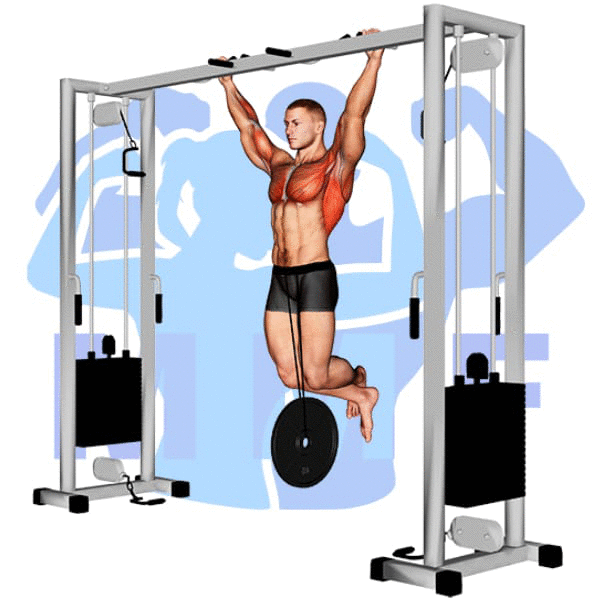Are you’re looking to tone and strengthen your upper body, incorporating pull arm exercises into your fitness routine is a must. Pull arm exercises are not only great for building strong and defined arms, but they also engage several other muscle groups such as your back, shoulders, and chest. Whether you’re a beginner or an advanced athlete, there are plenty of pull arm exercises that you can do at home or at the gym with or without equipment. So, let’s dive in and explore some of the best pull arm exercises that can take your upper body workout to the next level. Keep reading and start seeing the results for yourself!
- Benefits of Pull Arm Exercises
- Types of Pull Arm Exercises
- 100+ Most Popular and Effective Pull Arm Exercises
- Compound Exercise
- Bodyweight Compound Exercises
- Resistance Band Compound Exercises
- Barbell Compound Exercises
- Cable Compound Exercises
- Machine Compound Exercises
- Dumbbell Compound Exercises
- Isolation Pull Arm Exercises
- Resistance Band Isolation Exercises
- Barbell Isolation Exercises
- Cable Isolation Exercises
- Machine Isolation Exercises
- Dumbbell Isolation Exercises
- Effective Pull Arm Exercise Workout Routine
- Safety Considerations
- Conclusion
Benefits of Pull Arm Exercises
Benefits of Pull Arm Exercises Pull arm exercises not only help you build strong and toned arms, but they also have a number of other benefits. Here are some of the top benefits of including pull arm exercises in your workout routine:
Improved Grip Strength: Pull arm exercises work the muscles in your forearms that are responsible for gripping and holding objects. As you strengthen these muscles, your grip strength will improve, which can be helpful for a wide range of everyday activities, from carrying groceries to opening jars.
Better Posture: When you do pull arm exercises, you engage the muscles in your upper back and shoulders that help keep your shoulders back and your spine straight. Over time, this can help improve your posture and reduce the risk of back pain.
Stronger Upper Body: Pull arm exercises work the muscles in your arms, shoulders, chest, back, and core. This makes them an excellent way to build overall upper body strength.
Injury Prevention: By strengthening the muscles in your upper body, pull arm exercises can help prevent injury. If you participate in other sports or activities, having a strong upper body can help reduce the risk of injury.
Increased Muscle Definition: With consistent pull arm exercises, you’ll start to see increased muscle definition in your arms and shoulders. This can be a great confidence booster and a visual representation of your progress.
So if you want to improve your grip strength, posture, and overall upper body strength, consider adding pull arm exercises to your workout routine.
Types of Pull Arm Exercises
When it comes to pull arm exercises, there are two main categories: compound and isolation exercises. Compound exercises involve multiple muscle groups and joints, such as pull-ups or rows with a barbell. Isolation exercises, on the other hand, target specific muscles, such as bicep curls or tricep extensions. Both types of exercises have their benefits and can be incorporated into a well-rounded workout routine. However, it’s important to remember that proper form and technique are essential to prevent injury and maximize results.
100+ Most Popular and Effective Pull Arm Exercises
- Brachialis Pull Up
- Inverted Row Underhand Grip
- Inverted Rows
- Band Rear Deltoid Row
- Band Upright Row
- Barbell Bent Over Row
- Barbell Incline Row
- Barbell Pendlay Row
- Barbell Rear Delt Row
- Barbell Reverse Grip Bent Over Row
- EZ Bar Reverse Grip Bent Over Row
- Barbell Standing Upright Row
- Barbell Wide Grip Upright Row
- EZ Bar Upright Row
- Cable Rope Face Pull
- Cable Rope Rear Delt Rows
- Seated Cable Row
- Seated V Bar Cable Row
- Lever High Row (Machine)
- Lever One Arm Lateral High Row (Machine)
- Smith Machine Bent Over Row
- Smith Machine Rear Delt Row
- T Bar Reverse Grip Row
- T Bar Supported Reverse Grip Row
- Smith Machine Upright Row
- Dumbbell Bent Over Row
- Dumbbell Chest Supported Row
- Dumbbell One Arm Rear Deltoid Row
- Dumbbell One Arm Row
- Dumbbell Palm Rotational Bent Over Row
- Dumbbell Rear Deltoid Raise
- Dumbbell Supported One Arm Row
- Incline Dumbbell Rear Deltoid Row
- Underhand Dumbbell Row
- Dumbbell Upright Row
- Alternating Resistance Band Curl
- Band One Arm High Curl
- Concentration Curls With Bands
- Reverse Fly With Bands
- Shrugs With Bands
- Band Front Raise
- Lateral Raises With Bands
- One Arm Band Lateral Raise
- Barbell Drag Curl
- Barbell Preacher Curl
- Barbell Standing Close Grip Curl
- Barbell Standing Curl
- Barbell Standing Wide Grip Biceps Curl
- EZ Bar Close Grip Curl
- EZ Bar Close Grip Preacher Curl
- EZ Bar Curl
- EZ Bar Preacher Curl
- EZ Bar Spider Curl
- EZ Bar Standing Preacher Curl
- Barbell Rear Delt Raise
- Barbell Skier
- Barbell Shrug
- Barbell Front Raise
- Barbell Standing Front Raise Over Head
- Cable Concentration Curl
- Cable Rope Hammer Curl
- Cable V Bar Curls
- Close Grip Cable Curls
- One Arm Bicep Cable Curls
- One Arm Cable Curls
- One Arm Cable High Curl
- One Arm Preacher Cable Curl
- Overhead Cable Curls
- Single Arm Cable Concentration Curl
- Cable Crossover Reverse Flys
- Cable Shrug
- Cable Front Raises
- Cable Seated Rear Lateral Raise
- Cable Single Arm Forward Raise
- Single Arm Lateral Cable Raises
- Standing Cable Crossover Delt Fly
- Lever Hammer Grip Preacher Curl (Machine)
- Lever Preacher Curl (Machine)
- Smith Machine Shrug
- Lever Lateral Raise (Machine)
- Alternating Dumbbell Curls
- Alternating Dumbbell Hammer Curl
- Alternating Dumbbell Hammer Preacher Curl
- Alternating Dumbbell Preacher Curl
- Dumbbell Concentration Curl
- Dumbbell Cross Body Hammer Curl
- Dumbbell Curl
- Dumbbell Hammer Curl
- Dumbbell High Curl
- Dumbbell Preacher Hammer Curl
- Incline Alternating Dumbbell Hammer Curl
- Incline Dumbbell Biceps Curl
- Lying Dumbbell Supine Curl
- Seated Alternating Dumbbell Hammer Curl
- Stability Ball Dumbbell Concentration Curl
- Stability Ball Dumbbell Curl
- Stability Ball Dumbbell Hammer Curl
- Dumbbell Rear Lateral Raise
- Dumbbell Shrug
- Alternating Dumbbell Raise
- Alternating Dumbbell Vertical Front Raise
- Dumbbell Around The World
- Dumbbell Front Raise
- Dumbbell Full Can Lateral Raise
- Dumbbell Iron Cross
- Dumbbell Lateral Raise
- Incline Dumbbell Front Raise
- Incline Dumbbell Lateral Raise
- Incline Dumbbell One Arm Lateral Raise
- Incline Dumbbell Raise
- Incline Dumbbell Rear Lateral Raise
- Incline Dumbbell Rotating Lateral Raise
- Incline Dumbbell Single Arm Rear Lateral Raise
- Lying Dumbbell Rear Lateral Raise
- Seated Dumbbell Lateral Raise
- Seated Dumbbell Rear Lateral Raise
- Single Dumbbell Front Raise
Compound Exercise
If you want to build bigger and stronger arms, you should incorporate compound pull arm exercises into your workout routine. These exercises involve multiple muscle groups working together to lift a weight or resist a force. Not only do they target the biceps and triceps, but they also engage the forearms, back, and shoulders. Plus, compound exercises can be more efficient and effective than isolation exercises, which only work one muscle group at a time. For example, wide-grip pull-ups work the biceps, back muscles, and forearms, while also engaging the core and promoting good posture. So, add some of these compound exercises to your routine and see the results for yourself!
Bodyweight Compound Exercises
Brachialis Pull Up

Brachialis Pull Up is a great exercise to primarily target the brachialis muscles. It also engages the biceps and the back muscles. Compared to traditional pull-ups or chin-ups, Brachialis Pull Up puts less emphasis on the biceps and places more focus on the brachialis muscles, resulting in increased arm strength and overall upper body development.
Inverted Row Underhand Grip
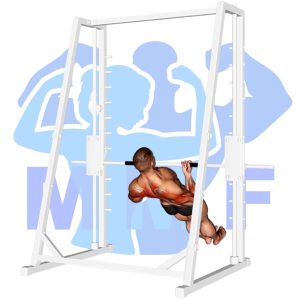
The Inverted Row Underhand Grip primarily targets the muscles of the back and arms while also engaging the core. Compared to other similar exercises like the Pull-Up, this variation is more accessible and beginner-friendly, making it a great choice for those who are new to strength training.
Inverted Rows

Inverted Rows are a great exercise for targeting the upper back muscles, including the rhomboids, traps and lats. Compared to other similar exercises like pull-ups or chin-ups, inverted rows are easier to perform and place less stress on the shoulder joints, making them a great option for beginners or those with shoulder issues.
Resistance Band Compound Exercises
Band Rear Deltoid Row

Band Rear Deltoid Row effectively targets the rear deltoid muscles, as well as strengthening the upper back and improving posture. This exercise is a great alternative to traditional dumbbell rows as it adds resistance throughout the movement, making it more challenging and effective.
Band Upright Row

Band upright row is an excellent exercise that primarily targets your shoulder muscles, including your deltoids and trapezius. Compared to barbell and dumbbell upright rows, band upright rows offer constant resistance throughout the movement and are gentler on the wrist and elbow joints, making it an excellent choice for individuals with joint pain or mobility issues.
Barbell Compound Exercises
Barbell Bent Over Row

The Barbell Bent Over Row is a compound exercise that primarily works the muscles in the back, including the lats, traps, and rhomboids. It also engages the biceps, forearms, and core. Although it is similar to other rowing exercises, such as the dumbbell row or cable row, the Barbell Bent Over Row allows for heavier loads to be lifted and emphasizes more muscle activation in the lower back.
Barbell Incline Row

The Barbell Incline Row is an excellent exercise that works the upper back muscles, including the rhomboids, rear deltoids, and trapezius. This exercise also engages the biceps and forearms, offering greater arm development compared to other back exercises like pull-ups or pull-downs. Overall, the Barbell Incline Row can help enhance upper body strength and improve posture.
Barbell Pendlay Row

The Barbell Pendlay Row is a highly effective exercise that targets several muscles, including the back, shoulders, and arms. This exercise is different from other rowing variations because it emphasizes explosiveness and proper body position, resulting in improved posture and overall strength.
Barbell Rear Delt Row
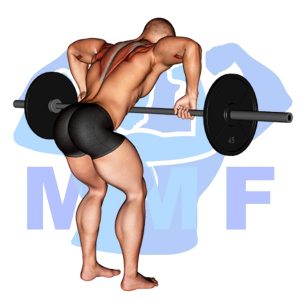
Barbell Rear Delt Row is an excellent exercise that targets the rear deltoids, rhomboids, and trapezius muscles. This exercise provides many benefits such as strengthening the upper back, improving posture, and preventing shoulder injuries, making it a must-do for anyone looking to build a strong back. Additionally, compared to other similar exercises like seated cable row, the Barbell Rear Delt Row allows for more significant weights and greater resistance, leading to greater muscle gains.
Barbell Reverse Grip Bent Over Row

Barbell Reverse Grip Bent Over Row primarily works the back muscles, including rhomboids, traps, and lats, as well as biceps and forearms. Compared to other similar exercises, this workout targets the lower lats better and allows for greater activation of the biceps.
EZ Bar Reverse Grip Bent Over Row

The EZ Bar Reverse Grip Bent Over Row primarily targets the back muscles, specifically the lats and rhomboids. It also engages the biceps and forearm muscles. Compared to traditional barbell rows, this exercise puts less strain on the lower back and allows for a wider range of motion.
Barbell Standing Upright Row

The Barbell Standing Upright Row targets the deltoid muscles, upper traps, and gives a great workout to the biceps and forearms. It offers more range of motion than other rowing exercises, making it a great choice to build broader shoulders and improve posture. However, it requires proper form to avoid shoulder impingement.
Barbell Wide Grip Upright Row

The Barbell Wide Grip Upright Row primarily works the shoulders, upper back, and upper arms. It also engages the core and lower body as stabilizers. Compared to other similar exercises like lateral raises, the wide grip upright row allows you to work with heavier weights, leading to increased strength and muscle growth.
EZ Bar Upright Row
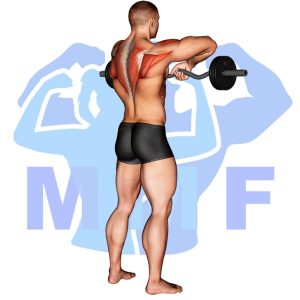
EZ Bar Upright Row targets the muscles in your shoulders, particularly the deltoids and traps. This exercise is a great alternative to other shoulder exercises as it emphasizes the lateral deltoids and provides a greater range of motion. Plus, the use of the EZ bar reduces stress on your wrists and elbows.
Cable Compound Exercises
Cable Rope Face Pull

The Cable Rope Face Pull is an effective exercise that works on the upper back, shoulders, and neck muscles. It is particularly beneficial for improving posture and reducing the risk of shoulder injuries compared to similar exercises like seated row or pull-downs.
Cable Rope Rear Delt Rows

Cable Rope Rear Delt Rows are a great exercise to strengthen your rear deltoids and upper back muscles. Compared to similar exercises, this movement allows for a greater range of motion and more control over the resistance.
Seated Cable Row

The Seated Cable Row mainly works the mid-back muscles, including the latissimus dorsi, rhomboids, and trapezius. Compared to other similar exercises like the Bent-Over Row or T-Bar Row, the Seated Cable Row puts less stress on the lower back and allows for a more controlled movement. Incorporating this exercise into your routine can improve posture, upper body strength, and overall back muscle development.
Seated V Bar Cable Row

Seated V Bar Cable Row is an excellent exercise for developing back muscles, particularly the lower and middle back. Compared to similar exercises like the bent-over barbell row, the Seated V Bar Cable Row provides a more controlled motion and less stress on the lower back.
Machine Compound Exercises
Lever High Row (Machine)

The Lever High Row machine targets the upper back, shoulders, and biceps. Unlike other rowing exercises, it isolates the muscles being worked and reduces strain on the lower back. Incorporating this exercise can improve posture and overall upper body strength.
Lever One Arm Lateral High Row (Machine)

The Lever One Arm Lateral High Row (Machine) is a great exercise for strengthening the upper back muscles, particularly the posterior deltoid and trapezius. Compared to other similar exercises, such as the seated cable row or dumbbell row, this exercise provides a more stable and controlled movement, reducing the risk of injury and allowing for better muscle targeting.
Smith Machine Bent Over Row
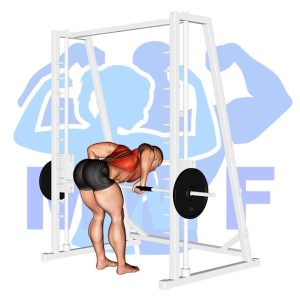
The Smith Machine Bent Over Row is an effective exercise that works multiple muscle groups including the back, biceps, and shoulders. Compared to traditional barbell rows, the Smith machine provides a more stable and controlled movement, reducing the risk of injury and allowing for heavier weights to be used.
Smith Machine Rear Delt Row

The Smith Machine Rear Delt Row targets the rear deltoids, middle and lower trapezius, and rhomboids muscles. Compared to other exercises, it offers a more controlled movement pattern and an adjustable range of motion, making it safer and more targeted.
T Bar Reverse Grip Row

The T Bar Reverse Grip Row is an exercise that primarily works your back muscles, particularly your lats and upper back. It also engages your biceps and forearms. This variation of the row is especially beneficial for targeting the hard-to-hit upper back muscles and building overall back thickness.
T Bar Supported Reverse Grip Row

The T Bar supported reverse grip row is an effective exercise that targets your back muscles, particularly your lats, traps, and rhomboids. Compared to other rowing exercises, this variation allows you to grip the bar closer to your body, placing more emphasis on your upper back muscles, and providing greater stability and support.
Smith Machine Upright Row
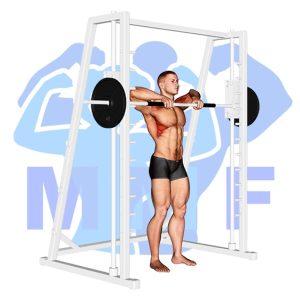
Smith Machine Upright Row is a great exercise to target your shoulders, upper back, and traps. Compared to other similar exercises, it provides more control and stability while lifting heavy weights, reducing the risk of injury.
Dumbbell Compound Exercises
Dumbbell Bent Over Row

The Dumbbell Bent Over Row is a back strength exercise that targets the lats, rhomboids, and trapezius muscles. Compared to similar exercises like the Barbell Bent Over Row, it allows for individual hand movement and increased range of motion for better muscle activation. This exercise can also improve posture and reduce the risk of injury in everyday activities.
Dumbbell Chest Supported Row

The Dumbbell Chest Supported Row primarily targets the upper back muscles, such as the rhomboids and trapezius. It also engages the rear deltoids and biceps. Compared to regular standing rows, the chest supported position provides more stability and isolation, allowing for more focus on the targeted muscles without compromising form.
Dumbbell One Arm Rear Deltoid Row

The Dumbbell One Arm Rear Deltoid Row primarily works the rear deltoid muscles located at the back of your shoulders. It also targets your upper back and traps. This exercise is an excellent variation of the traditional dumbbell row, specifically targeting the rear delts, which are often neglected in other similar exercises.
Dumbbell One Arm Row

Dumbbell One Arm Row is an effective exercise that mainly targets your back muscles. It also works your biceps and shoulders. Compared to exercises like lat pulldowns, the Dumbbell One Arm Row allows for greater range of motion and helps improve your grip strength.
Dumbbell Palm Rotational Bent Over Row

The Dumbbell Palm Rotational Bent Over Row is a great exercise to target your back, biceps, and forearms. It helps improve your grip strength and increases muscle activation compared to traditional bent over rows. Additionally, the palm rotation engages more of your back muscles, making it an effective exercise to add to your workout routine.
Dumbbell Rear Deltoid Raise

The Dumbbell Rear Deltoid Raise is an excellent exercise for strengthening the posterior deltoids, which are the muscles located at the back of your shoulders. This exercise is highly effective in isolating and targeting the rear deltoids, whereas other similar exercises such as the bent-over row, work multiple muscles including the lats and biceps.
Dumbbell Supported One Arm Row
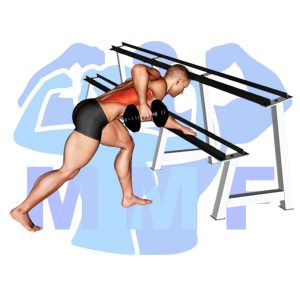
Dumbbell Supported One Arm Row targets multiple muscles including the lats, rhomboids, and biceps. This exercise also allows for a greater range of motion compared to traditional seated row machines, promoting better overall back strength and function.
Incline Dumbbell Rear Deltoid Row

The Incline Dumbbell Rear Deltoid Row is a great exercise for targeting your rear deltoids, traps and upper back muscles. Compared to other similar exercises, this movement allows for an increased range of motion and provides more isolation for the targeted muscles, resulting in better overall growth and strength gains.
Underhand Dumbbell Row
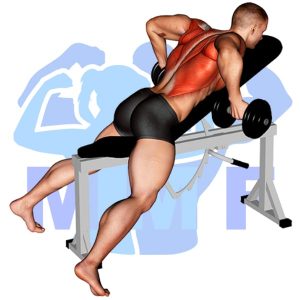
The Underhand Dumbbell Row mainly works the muscles of the back, shoulders, and biceps. Compared to other exercises like the Bent-over Barbell Rows, it places less stress on the lower back and is a safer option for beginners. Additionally, it provides a greater range of motion, helping to build muscle tone and definition in the target muscles.
Dumbbell Upright Row

The dumbbell upright row is a compound exercise that primarily works the shoulders and upper back muscles. It also engages the biceps and triceps. Compared to similar exercises like the lateral raise, the upright row targets a wider range of muscles and can create a more defined upper body.
Isolation Pull Arm Exercises
Doing isolation pull arm exercises alongside compound pull arm exercises is important because isolation exercises target specific muscles in your arms that may not be worked as effectively during compound exercises. Compound exercises like pull-ups, rows, and chin-ups work multiple muscle groups in your arms, but they may not necessarily target smaller, weaker muscles like your biceps or triceps. Isolation exercises like bicep curls and tricep extensions help to strengthen these smaller, weaker muscles and prevent imbalances in your arms. Additionally, by strengthening these smaller muscles, you can improve your overall performance in compound exercises because you’ll have more strength and stability in your arms. Think of it like this: if you only do compound exercises, it’s like trying to paint an entire room with just one large paintbrush. Sure, you’ll cover a lot of ground, but you may not get into all the small nooks and crannies that require more precision. Isolation exercises are like using a smaller, more precise paintbrush to get those hard-to-reach areas. By combining both types of exercises, you’ll get a more well-rounded workout that targets all the muscles in your arms for optimal strength and performance.
Resistance Band Isolation Exercises
Alternating Resistance Band Curl
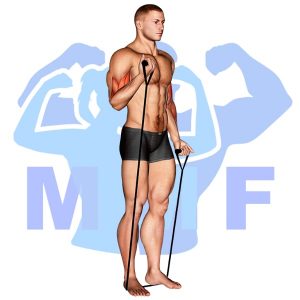
The alternating resistance band curl is a simple yet effective exercise that primarily targets the biceps muscles. It provides unique benefits compared to traditional dumbbell curls, such as constant tension on the muscles throughout the movement and the ability to easily adjust resistance levels.
Band One Arm High Curl
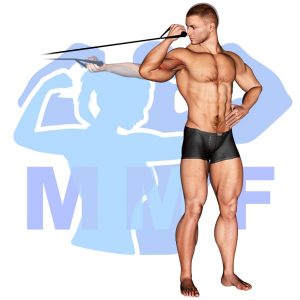
The Band One Arm High Curl is a great exercise to target your biceps and upper arm muscles. It is especially effective compared to other similar exercises because it isolates the biceps and prevents the use of momentum from other muscles. Adding this exercise to your workout routine will help you develop stronger and more defined biceps.
Concentration Curls With Bands

Concentration curls with bands mainly target the biceps brachii muscle while also engaging the brachialis muscle. This exercise activates and strengthens the biceps without putting a strain on the wrists, unlike dumbbell curls. It also provides constant tension throughout the movement, resulting in greater muscle activation and growth.
Reverse Fly With Bands

Reverse Fly With Bands targets the upper back, shoulders and postural muscles. Unlike traditional weight lifting exercises, bands offer a resistance that increases as the band stretches, providing a safer and more controlled workout. This exercise can help improve posture and reduce the risk of injury.
Shrugs With Bands
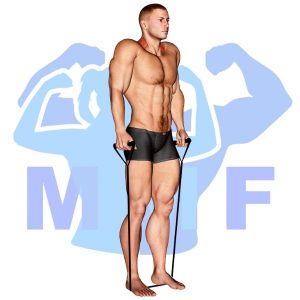
Shrugs with bands primarily target the trapezius muscles, but also work the shoulders, neck, and upper back. Using the resistance bands allows for greater range of motion and a deeper contraction compared to traditional dumbbell shrugs, resulting in improved muscle activation and growth.
Band Front Raise

Band front raises are a fantastic exercise for the shoulders and upper back muscles. They target the anterior deltoids and help improve posture and stability, making them a great alternative to dumbbell front raises or overhead presses.
Lateral Raises With Bands
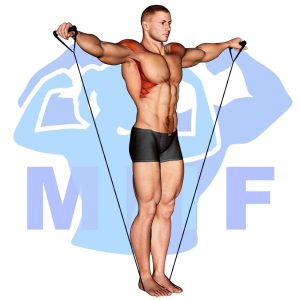
Lateral raises with bands target the middle and upper shoulder muscles. This exercise is great for shoulder stability and strengthening, and can provide a more in-depth workout than traditional shoulder press movements. Compared to dumbbell lateral raises, using bands allows for more range of motion and added resistance at the top of the movement.
One Arm Band Lateral Raise

The One Arm Band Lateral Raise targets the medial deltoids, which are located on the side of the shoulders. This exercise helps to sculpt and define the shoulders, while also improving shoulder stability and mobility. Unlike traditional dumbbell lateral raises, the resistance band provides constant tension throughout the movement, making it more challenging and effective.
Barbell Isolation Exercises
Barbell Drag Curl
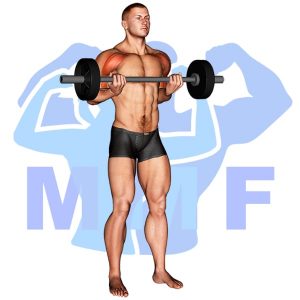
The Barbell Drag Curl primarily targets the biceps brachii, but also involves the brachialis and brachioradialis muscles. Compared to traditional bicep curls, the drag curl places more emphasis on the brachialis and can help improve overall arm strength and aesthetics.
Barbell Preacher Curl

Barbell Preacher Curl is a great exercise for targeting the biceps, as well as the forearms and upper arms. This exercise is more isolated than standing curls, making it great for building muscle strength and size.
Barbell Standing Close Grip Curl
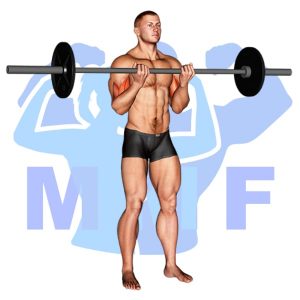
Barbell Standing Close Grip Curl primarily targets the biceps brachii, brachialis, and brachioradialis muscles. Compared to other bicep exercises, the close grip curl places greater emphasis on the brachialis muscle, which helps to increase overall arm thickness and definition.
Barbell Standing Curl

The Barbell Standing Curl is an excellent exercise to work on your biceps, forearms, and grip strength. Compared to other similar exercises like the hammer curl or preacher curl, the standing curl allows you to target a larger range of motion and engage more muscle fibers.
Barbell Standing Wide Grip Biceps Curl
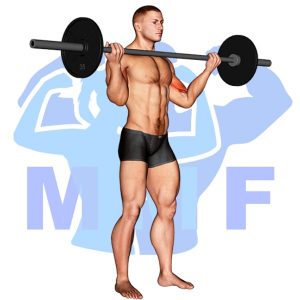
The Barbell Standing Wide Grip Biceps Curl primarily targets the biceps brachii muscle group, but also engages the brachialis and brachioradialis muscles as secondary targets. As compared to other similar biceps exercises, this movement allows for a wider grip, increasing the range of motion and providing a greater stretch for the muscle fibers.
EZ Bar Close Grip Curl

The EZ Bar Close Grip Curl primarily works the biceps and forearms, with some involvement from the shoulders and upper back muscles. Compared to other similar exercises like the straight bar curl, the EZ Bar Close Grip Curl places less stress on the wrists and allows for a greater range of motion, making it a great variation to add to your arm workout.
EZ Bar Close Grip Preacher Curl

The EZ Bar Close Grip Preacher Curl is an excellent exercise to strengthen the biceps, particularly the short head. It provides more isolation to the bicep muscle compared to other similar exercises such as the standing barbell curl or dumbbell curl. Additionally, it reduces strain on the wrists and forearms, making it easier to isolate the bicep muscle.
EZ Bar Curl

EZ Bar Curl primarily targets the biceps and forearms. It is a more comfortable alternative to straight bar curls and reduces strain on the wrists. The exercise also helps to increase bicep strength and size when performed correctly.
EZ Bar Preacher Curl

EZ Bar Preacher Curl primarily works on the biceps, brachialis, and brachioradialis muscles. It offers a more isolated movement compared to standing curls, enabling better targeting of the brachialis. It’s also easier on the wrists and elbows than straight bar preacher curls.
EZ Bar Spider Curl

The EZ Bar Spider Curl is a great exercise to work the biceps and forearm muscles. This curl is a variation of the classic bicep curl which mainly targets the short head of the biceps brachii, making it highly effective for building mass and strength in that area. Compared to other bicep curls, the EZ Bar Spider Curl provides better isolation of the biceps muscle, resulting in faster muscle growth and overall improvement in arm strength.
EZ Bar Standing Preacher Curl

The EZ Bar Standing Preacher Curl primarily targets the biceps brachii muscles. It also engages the brachialis and brachioradialis muscles. Compared to other similar exercises, such as the regular standing barbell curl, the preacher curl provides better isolation for the biceps and reduces strain on the wrists.
Barbell Rear Delt Raise

Barbell Rear Delt Raise is an excellent exercise that specifically targets the rear deltoids, the muscles at the back of the shoulders. Compared to other similar exercises, it places less stress on the upper traps and more emphasis on the rear delts, resulting in better muscle development and improved posture.
Barbell Skier

Barbell skier is an excellent exercise that primarily works your quads, glutes, and calves. It’s a low-impact alternative to other exercises like jump squats or box jumps but still provides a high-intensity workout.
Barbell Shrug

Barbell shrug is a great exercise that targets your upper trapezius muscles, which are important for shoulder mobility and stability. Compared to other similar exercises like dumbbell shrugs, barbell shrugs allow you to lift heavier weights and challenge your muscles more effectively for better gains.
Barbell Front Raise

Barbell Front Raise primarily targets the anterior deltoid muscle of shoulders, along with the upper pectoralis major and serratus anterior. Compared to lateral raises, this exercise tends to target the front deltoid more specifically. Additionally, it can also help improve core and back stability due to its total body engagement.
Barbell Standing Front Raise Over Head
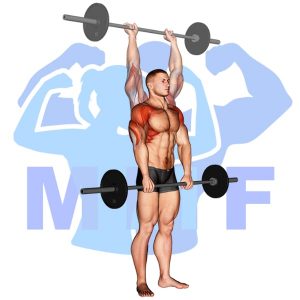
The Barbell Standing Front Raise Overhead primarily targets the front deltoids, as well as the trapezius and upper chest muscles. This exercise is great for building shoulder strength and stability, and is a more compound move than similar isolation exercises like the front raise with dumbbells.
Cable Isolation Exercises
Cable Concentration Curl
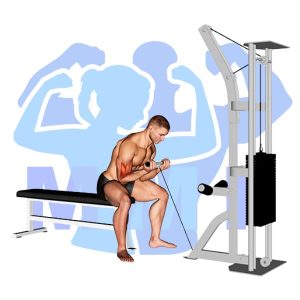
The Cable Concentration Curl primarily targets the biceps muscles. It differs from traditional bicep curls by providing constant tension on the muscles throughout the entire movement. This exercise is perfect for isolating the biceps and improving overall arm strength.
Cable Rope Hammer Curl

The Cable Rope Hammer Curl is a fantastic exercise for targeting the brachialis and biceps muscles in the upper arms. Unlike other similar exercises, such as dumbbell curls, the cable rope hammer curl provides constant tension throughout the movement, resulting in greater muscle activation and improved strength gains.
Cable V Bar Curls

Cable V bar curls primarily target the biceps, specifically the short head. This exercise is advantageous compared to other similar exercises because it allows for a greater range of motion and enables the muscles to be worked from different angles, leading to improved muscle growth and strength.
Close Grip Cable Curls

Close Grip Cable Curls are an effective exercise that works primarily on the biceps muscles. They are a versatile exercise that is easy to perform and isolates the biceps, unlike other exercises like pull-ups that also work on other muscle groups.
One Arm Bicep Cable Curls

The One Arm Bicep Cable Curls is an exercise that focuses primarily on the biceps. It provides benefits such as increased muscle definition and strength compared to other similar exercises like the dumbbell curls. Additionally, this exercise engages stabilizer muscles in the core and shoulders for improved balance and posture.
One Arm Cable Curls

One Arm Cable Curls are a great exercise for building biceps and forearm muscles. The use of cables helps maintain constant resistance throughout the movement, making it an effective exercise compared to dumbbell curls or barbell curls.
One Arm Cable High Curl

The One Arm Cable High Curl is a great exercise to target the biceps muscles in isolation. It helps to develop peak contraction and flexibility for the biceps, compared to other similar exercises like the standing barbell curls or the incline dumbbell curls. Incorporating this exercise in your workout routine can help you achieve stronger and better-defined biceps.
One Arm Preacher Cable Curl
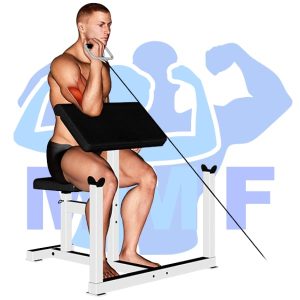
The One Arm Preacher Cable Curl targets the biceps muscle and helps in building overall arm strength. This exercise is more effective than traditional bicep curls as it isolates the muscle and prevents cheating. Moreover, it also engages the brachialis muscle, which is responsible for enhancing the width of the upper arms.
Overhead Cable Curls

Overhead Cable Curls target the biceps brachii muscles, as well as the brachialis and brachioradialis muscles. This exercise promotes upper arm strengthening and stability, with the added benefit of more consistent resistance than free weight exercises.
Single Arm Cable Concentration Curl

The Single Arm Cable Concentration Curl is an excellent exercise that works the bicep muscles, particularly the short head. It also improves grip strength, stability, and helps prevent muscle imbalances, unlike traditional bicep curls.
Cable Crossover Reverse Flys

Cable crossover reverse flys primarily target the rear deltoids, upper back, and shoulder blade muscles. This exercise can be a great alternative for people who experience discomfort or pain when performing dumbbell reverse flys. Additionally, cable crossover reverse flys offer a greater range of motion and better muscle isolation compared to traditional reverse flys.
Cable Shrug

Cable shrug exercise specifically works on the trapezius muscle that spans across the top of your back, neck, and shoulders. Unlike barbell shrugs, cable shrugs provide constant tension throughout the entire range of motion, allowing for greater muscle activation and growth. Additionally, cable shrugs offer a more controlled movement, reducing the risk of injury and allowing for better mind-muscle connection.
Cable Front Raises

Cable front raises target the front deltoids, which are responsible for raising the arms in front of the body. Compared to dumbbell front raises, cable front raises provide a constant tension on the muscles throughout the movement, making it a more effective exercise for muscle activation and growth.
Cable Seated Rear Lateral Raise

The Cable Seated Rear Lateral Raise is a great exercise for targeting the rear deltoids, trapezius, and upper back muscles. Unlike similar exercises with dumbbells, cables provide constant tension throughout the movement, making it a great option for muscle growth and strength. Additionally, the seated position allows for better stability, reducing the risk of injury.
Cable Single Arm Forward Raise

The Cable Single Arm Forward Raise is a great exercise to target the front deltoid muscle. It also helps to improve shoulder stability and balance. Compared to similar exercises, like dumbbell front raises, the cable variation provides consistent resistance throughout the movement.
Single Arm Lateral Cable Raises

Single arm lateral cable raises work primarily on the side shoulder muscles, also known as the lateral deltoids. This exercise also helps to improve shoulder stability and can be more effective in isolating the targeted muscles compared to traditional dumbbell lateral raises.
Standing Cable Crossover Delt Fly

The Standing Cable Crossover Delt Fly is an effective workout for developing the shoulder muscles. It targets the rear deltoids, traps, and rhomboids more efficiently compared to other similar exercises like the bent-over reverse fly or seated cable rows. This exercise can also help improve posture and stability.
Machine Isolation Exercises
Lever Hammer Grip Preacher Curl (Machine)

The Lever Hammer Grip Preacher Curl (Machine) primarily works the biceps and forearm muscles. The benefits of this exercise include greater isolation of the biceps and less strain on the wrists compared to traditional barbell curls. Additionally, the machine provides a consistent resistance throughout the movement.
Lever Preacher Curl (Machine)

The Lever Preacher Curl is a machine-based exercise that works the biceps brachii muscle group. The machine is designed to provide constant resistance throughout the range of motion, making it more effective than other similar exercises like dumbbell curls or barbell curls. Adding this exercise to your routine can improve bicep strength and hypertrophy, ultimately improving your overall arm aesthetics.
Smith Machine Shrug

The Smith Machine Shrug works the traps, which are responsible for shoulder movement and stabilization. Compared to dumbbell shrugs, it allows for a more controlled motion and eliminates the need for balance, making it easier for beginners.
Lever Lateral Raise (Machine)

The Lever Lateral Raise is a machine-based exercise that targets the lateral deltoids in the shoulders. This exercise is particularly effective at isolating and strengthening this area of the shoulder compared to similar exercises like dumbbell lateral raises. Incorporating this exercise into your routine can help improve shoulder stability and posture.
Dumbbell Isolation Exercises
Alternating Dumbbell Curls
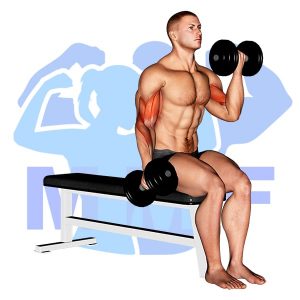
Alternating dumbbell curls are an excellent exercise for building biceps and forearm muscles. Compared to barbell curls, they allow for a greater range of motion and can improve arm strength and coordination.
Alternating Dumbbell Hammer Curl

The Alternating Dumbbell Hammer Curl is a great exercise that primarily targets the biceps and forearms. This exercise is highly effective in building bicep and forearm strength which helps in improving grip strength and overall upper body functionality. Compared to traditional bicep curls, the hammer curl engages the brachioradialis muscle which make it a great addition to any upper body workout.
Alternating Dumbbell Hammer Preacher Curl
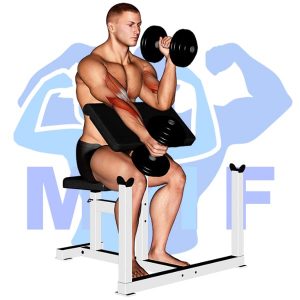
The Alternating Dumbbell Hammer Preacher Curl is an exercise that targets the biceps, forearms, and brachialis. This exercise is effective in building strength and size in the upper arms and is an excellent alternative to traditional bicep curls as it places less strain on the wrists.
Alternating Dumbbell Preacher Curl
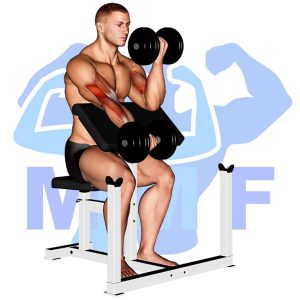
The Alternating Dumbbell Preacher Curl is a fantastic exercise for targeting the biceps and improving arm strength. Unlike traditional bicep curls, preacher curls isolate the muscle group, leading to better muscle activation and growth. Incorporating this exercise into your routine can lead to more defined and toned biceps.
Dumbbell Concentration Curl

Dumbbell concentration curl is a targeted exercise that primarily works the biceps muscle. This exercise is highly effective for building definition in your upper arms, especially compared to other similar exercises like hammer curls or preacher curls.
Dumbbell Cross Body Hammer Curl

Dumbbell Cross Body Hammer Curl targets the biceps brachii and forearms. It is a great alternative to traditional bicep curls as it engages additional muscle groups and helps improve muscle imbalances in the arms. Adding this exercise to your workout routine can enhance your overall arm strength and definition.
Dumbbell Curl

Dumbbell curls work primarily on the biceps, forearm flexors, and brachialis muscles. Compared to similar exercises like bicep curls with a barbell or cable, dumbbell curls provide more freedom of movement and allow for greater range of motion. Additionally, you can easily adjust the weight of the dumbbells and focus on each arm separately to improve muscle imbalances.
Dumbbell Hammer Curl

The dumbbell hammer curl primarily works the biceps brachii, brachialis, and brachioradialis muscles. It can be more effective than traditional bicep curls due to the neutral grip, which puts less stress on the wrists and forearms. Additionally, hammer curls can help to improve grip strength and add variety to your arm workout routine.
Dumbbell High Curl

Dumbbell High Curl is a great exercise that primarily targets the biceps muscles. It is also beneficial for those who want to develop the upper portion of their bicep as compared to other curl exercises that only target the lower portion.
Dumbbell Preacher Hammer Curl

The Dumbbell Preacher Hammer Curl primarily targets the biceps and forearms. This exercise also provides better isolation to the biceps compared to other similar standing bicep curls. Additionally, it reduces the use of momentum, leading to better muscle contraction and development.
Incline Alternating Dumbbell Hammer Curl

The Incline Alternating Dumbbell Hammer Curl is a great exercise that targets the biceps, forearms, and brachialis muscles. Compared to other arm exercises, this exercise places less strain on the wrists and elbows while providing a great overall arm workout.
Incline Dumbbell Biceps Curl

The Incline Dumbbell Biceps Curl is an excellent exercise for targeting the biceps and increasing upper arm strength. This exercise puts more emphasis on the long head of the biceps and also engages the brachialis muscles. Compared to other similar exercises like standing biceps curls, the incline angle helps to reduce cheating and engage the muscles more efficiently.
Lying Dumbbell Supine Curl

The Lying Dumbbell Supine Curl primarily targets the biceps brachii muscles. It is similar to other bicep curl exercises, but it provides more activation to the biceps due to the supine position. This exercise also involves the core muscles for stabilization.
Seated Alternating Dumbbell Hammer Curl

The Seated Alternating Dumbbell Hammer Curl primarily works the biceps brachii and brachialis muscles. It also provides a more neutral grip compared to other bicep exercises, reducing strain on the wrist and forearm muscles while increasing muscle activation in the brachialis.
Stability Ball Dumbbell Concentration Curl

The Stability Ball Dumbbell Concentration Curl is a great exercise to strengthen and tone the biceps. This exercise also engages the core and stabilizer muscles more than standard concentration curls, making it a more challenging and effective exercise. Compared to regular bicep curls, using a stability ball forces your muscles to work harder to maintain balance and control, resulting in improved muscular stability and coordination.
Stability Ball Dumbbell Curl
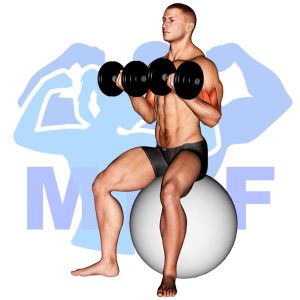
The Stability Ball Dumbbell Curl is an effective exercise that targets the biceps and forearms while also engaging the core and stabilizer muscles. Compared to traditional dumbbell curls, this exercise requires more balance and coordination, resulting in increased muscle activation and improved overall strength and stability.
Stability Ball Dumbbell Hammer Curl

The Stability Ball Dumbbell Hammer Curl mainly targets the biceps, brachialis, and forearms. Unlike traditional dumbbell curls, this exercise also engages your core muscles as you balance on the stability ball, enhancing overall stability and balance while building upper body strength.
Dumbbell Rear Lateral Raise

The Dumbbell Rear Lateral Raise is a great exercise targeting the rear deltoids (shoulder muscles). This exercise is unique as it helps in strengthening the muscles responsible for shoulder stabilization and improved posture. Unlike similar exercises like seated row or reverse fly, this exercise can be performed in different variations and focuses on building well-defined back muscles.
Dumbbell Shrug
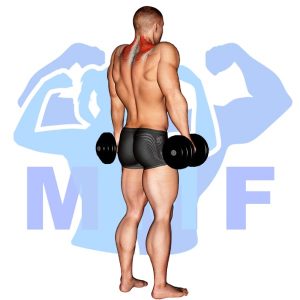
Dumbbell shrug is an effective exercise that primarily targets the trapezius muscles of the shoulders and upper back. It also engages the neck and upper chest muscles. Compared to other similar exercises like upright rows, shrugs allow for heavier weights to be used and isolates the targeted muscle groups more effectively.
Alternating Dumbbell Raise

The Alternating Dumbbell Raise primarily works the shoulders, specifically the anterior and medial deltoids. In comparison to other exercises targeting the same muscles, such as lateral raises, the alternating dumbbell raise provides a greater range of motion and allows for more control and focus on each individual arm. Additionally, incorporating this exercise into your routine can improve overall shoulder stability and strength.
Alternating Dumbbell Vertical Front Raise

The Alternating Dumbbell Vertical Front Raise primarily targets the anterior deltoids but also engages the lateral deltoids and upper traps. It is a more challenging variation of the standard front raise, and it helps improve shoulder strength, stability, and posture. Compared to the barbell front raise, the alternating dumbbell version offers greater range of motion and allows for unilateral training to address muscular imbalances.
Dumbbell Around The World

Dumbbell Around The World is a great exercise to tone and strengthen your shoulder muscles. It also engages your core and improves balance and stability, making it a better option than traditional shoulder press or lateral raises.
Dumbbell Front Raise

Dumbbell Front Raise targets the anterior deltoid muscle, which helps to lift objects in front of the body. Compared to exercises like the Shoulder Press or Lateral Raise, it places more emphasis on the front of the shoulder. Regularly performing this exercise can improve shoulder strength and stability.
Dumbbell Full Can Lateral Raise

The Dumbbell Full Can Lateral Raise is an excellent exercise to target the smaller muscles in the rotator cuff as well as the deltoids. Unlike traditional lateral raises, this exercise puts less strain on the shoulder joint, making it a safer option for individuals with shoulder issues. It also helps improve posture and stability, making it a great addition to any upper body workout routine.
Dumbbell Iron Cross

The Dumbbell Iron Cross is a great exercise to target the chest, shoulders, and triceps. Compared to traditional bench press, this exercise helps in developing better muscle balance and coordination. Additionally, it can also improve posture and stability.
Dumbbell Lateral Raise

The Dumbbell Lateral Raise is an effective exercise that mainly targets the deltoid muscles. It is beneficial for improving shoulder strength, stability, and posture. It differs from other shoulder exercises like overhead press and front raise, as it specifically targets the lateral (side) deltoid, providing a well-rounded shoulder workout.
Incline Dumbbell Front Raise

The Incline Dumbbell Front Raise mainly targets the shoulders, particularly the anterior deltoids. This exercise activates the muscle fibers in a different way compared to other shoulder exercises, which is beneficial for overall shoulder development. Additionally, this exercise can also help in improving posture and reducing the risk of shoulder injuries.
Incline Dumbbell Lateral Raise

The Incline Dumbbell Lateral Raise primarily targets the medial deltoids, but also works the front deltoids and upper trapezius. It is a great alternative to traditional lateral raises, as the incline position puts less stress on the shoulder joint, making it a safer exercise. It also allows for a greater range of motion and increased isolation of the targeted muscles.
Incline Dumbbell One Arm Lateral Raise

The Incline Dumbbell One Arm Lateral Raise mainly targets the lateral deltoid, while also working the anterior deltoid and rotator cuff muscles. This exercise provides a greater range of motion compared to the seated or standing lateral raises, making it an excellent isolation exercise to target the lateral deltoid.
Incline Dumbbell Raise

The Incline Dumbbell Raise is a great exercise that targets the front shoulder muscles, particularly the anterior deltoids. It is more effective than the traditional shoulder press because it allows for a wider range of motion, leading to better strength gains and muscle definition. Incorporating this exercise into your routine can improve overall shoulder strength and prevent imbalances that can lead to injury.
Incline Dumbbell Rear Lateral Raise

Incline dumbbell rear lateral raise is a great exercise that targets the rear deltoids, upper back muscles, rotator cuff, and trapezius. Unlike other similar exercises such as reverse fly or bent-over lateral raise, it allows for a greater range of motion and targets the upper back muscles more effectively.
Incline Dumbbell Rotating Lateral Raise

The Incline Dumbbell Rotating Lateral Raise mainly targets the shoulder muscles, especially the lateral deltoid. This exercise can also hit the rotator cuff muscles, which are important for shoulder stability. Compared to traditional lateral raises, the rotating motion that occurs in this exercise places less strain on the shoulder joint.
Incline Dumbbell Single Arm Rear Lateral Raise

The Incline Dumbbell Single Arm Rear Lateral Raise targets the rear deltoids, upper back, and trapezius muscles. This exercise is great for improving shoulder stability, posture, and upper body strength compared to similar exercises like bent over lateral raises.
Lying Dumbbell Rear Lateral Raise

The Lying Dumbbell Rear Lateral Raise targets the rear deltoids and upper back muscles. This exercise provides a greater range of motion and activation of these muscles compared to standing or seated rear lateral raises. Incorporating the lying dumbbell variation can help improve shoulder stability and posture.
Seated Dumbbell Lateral Raise

The Seated Dumbbell Lateral Raise primarily targets the middle deltoids, along with the trapezius and rotator cuff muscles. This exercise is particularly effective at isolating the shoulders, compared to other similar exercises like the Bent-Over Lateral Raise, which also engages the lower back and glutes. Incorporating Seated Dumbbell Lateral Raise into your workout routine can help improve shoulder strength, stability and mobility.
Seated Dumbbell Rear Lateral Raise

The Seated Dumbbell Rear Lateral Raise targets the posterior deltoids, upper back, and trapezius muscles, which are essential for healthy shoulder function. This exercise is especially useful for people who want to improve their posture and reduce shoulder and neck pain. Compared to other similar exercises, such as the bent-over lateral raise, the seated dumbbell rear lateral raise is easier to perform with proper form and provides greater control and precision in targeting the muscles.
Single Dumbbell Front Raise

The Single Dumbbell Front Raise primarily targets the anterior delts, but also works the lateral and posterior deltoid muscles. Compared to other similar exercises like the traditional front raise or lateral raise, the single dumbbell version places more emphasis on stabilizer muscles and can help improve overall shoulder strength and stability.
Effective Pull Arm Exercise Workout Routine
The weight you should start with for each exercise in this routine will depend on your individual fitness level and strength. Here are some general guidelines to help you determine your starting weight. For each exercise choose a weight that you can comfortably perform 10 reps with good form.
Once you have determined your starting weight for each exercise, you should increase the weight as you progress through the sets. Aim to increase the weight by a small at least 5-10 pounds for each set, while still maintaining good form. This will help you to gradually increase your strength and muscle mass over time.
| Exercise | Set 1 | Set 2 | Set 3 | Rest |
|---|---|---|---|---|
| Cable Lat Pulldowns | 10 reps | 8 reps | 6 reps (increase weight) | 60 seconds |
| Barbell Rows | 10 reps | 8 reps | 6 reps (increase weight) | 60 seconds |
| Narrow Grip Seated Cable Rows | 10 reps | 8 reps | 6 reps (increase weight) | 60 seconds |
| Alternating Dumbbell Curls | 10 reps (each arm) | 8 reps (each arm) | 6 reps (each arm, increase weight) | 60 seconds |
| Hammer Curls | 10 reps (each arm) | 8 reps (each arm) | 6 reps (each arm, increase weight) | 60 seconds |
| Reverse Grip Barbell Curls | 10 reps | 8 reps | 6 reps (increase weight) | 60 seconds |
Safety Considerations
While pull arm exercises can be effective in strengthening your arm muscles, it’s important to keep in mind some safety considerations before starting any workout routine.
First, make sure to warm up properly before beginning any exercise. Doing light cardio, such as jumping jacks or jogging in place, for five to ten minutes can help loosen up your muscles and prevent injury.
Second, start with lighter weights and gradually increase the weight as your strength improves. Don’t push yourself too hard, as overexertion can lead to muscle strains or even more serious injuries.
Third, maintain proper form throughout each exercise. Incorrect form can put unnecessary strain on your muscles and joints, increasing the risk of injury. If you’re unsure of how to perform an exercise properly, ask a certified trainer for guidance.
Fourth, if you experience any pain or discomfort during an exercise, stop immediately and consult with a healthcare professional. Continuing to exercise through pain can exacerbate an injury and prolong the recovery process.
Lastly, make sure to give your muscles proper rest and recovery time between workouts. This can prevent overuse injuries and promote overall muscle health. By following these safety considerations, you can safely and effectively strengthen your arm muscles through pull arm exercises.
Conclusion
In conclusion, pull arm exercises are crucial for strengthening your upper body, improving your posture, and enhancing your overall arm definition. By incorporating a variety of exercises such as pull-ups, rows, and curls, you can target different muscles in your arms and avoid plateauing in your progress. Remember to always listen to your body and start with a weight or resistance amount that is appropriate for your fitness level. Consistency is key, so aim to incorporate these exercises into your workout routine at least two to three times per week.
Finaly, don’t forget the importance of proper form and technique. Using proper form not only prevents injury but also increases the effectiveness of the exercise.
Incorporate these pull arm exercises into your workout routine and watch your arms get stronger and more defined over time. Keep pushing yourself, but don’t forget to have fun and enjoy the journey towards your fitness goals!
References: Best Pull Arm Exercises of All Time



